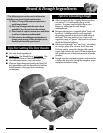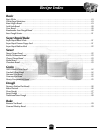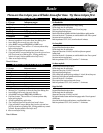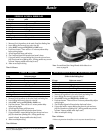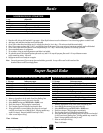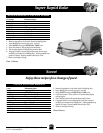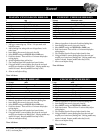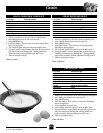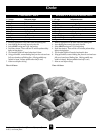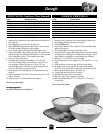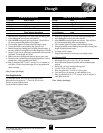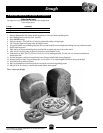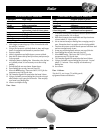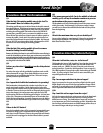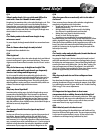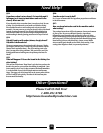
Need Help?
Q11:
When I make dough, it is very sticky and difficult to
work with. How can I handle it more easily?
Dough may be somewhat sticky at the end of the dough cycle. This
is normal. For best results, turn it out of the Baking Pan onto a
floured surface, cover it and let it rest for 10 minutes. Lightly flour
the board and your hands when handling the dough. This will
make it easier to shape and divide. Once shaped, the dough must
then be baked in a conventional oven.
Q12:
Can I bake products formed from doughs in my
microwave oven?
No, once shaped, the dough must be baked in a conventional oven.
Q13:
How do I know when dough is ready to bake?
Dough should have doubled in size.
Q14:
What is gluten?
Gluten is the protein in flour that makes dough elastic and allows it
to stretch and expand. It gives your bread structure. The amount
of gluten varies from one flour to another. See the “Flours”section.
Q15:
Why do the loaves vary in height and weight? The
whole wheat and multi-grain breads are frequently
shorter. Am I doing something wrong?
No, it is normal for whole wheat and multi-grain breads to be
shorter and denser than basic white breads.Whole wheat and rye
flours are heavier than white flour, therefore, they don’t rise as
much during the bread making process.They also typically have
added ingredients, such as oats, bran,nuts and raisins, which con-
tribute to the shorter height and denser texture.
Q16:
Why is my bread lopsided?
Sometimes when mixing stops, the ball of dough ends up at one
extreme side of the Baking Pan. That’s because in a horizontal
Baking Pan, the Mixing Paddle may bat the dough off to one side.
During the rising cycle, the dough may not have time to spread
evenly throughout the Pan. Though the results may look a little
odd, and you’ll have slices of different sizes, the bread will be just as
delicious as an evenly shaped loaf.
Q17:
Can I use my favorite bread recipes in my bread
machine?
Yes,but you will need to experiment to get the right proportion of
ingredients. Become familiar with the unit and make several
loaves of bread before you begin experimenting. Never exceed a
total amount of 4-1/4 cups of dry ingredients (that includes flours,
oats, cornmeal, bran cereal, cracked wheat, etc.). Use the recipes in
this book to help determine the ratio of dry ingredients to liquid
and amounts of yeast, sugar, salt, and butter/margarine to use.
Q18:
Why does some flour occasionally stick to the side of
the bread?
There are many factors that may affect whether a dough mixes
completely or ingredients stick to the sides:
• Dough may be too dry (ingredients may have been
measured incorrectly).
• Mixing Paddle was not placed correctly in the Baking
Pan. Be sure it is pushed securely onto the shaft.
• Baking Pan is not placed in the unit correctly.
Be sure to “lock” the Pan into place.
• Ingredients were not added in the recommended order.
Sometimes during the initial mixing period, small amounts of flour
and dry ingredients may get stuck to the sides of the Baking Pan.
When the loaf rises and bakes, the dry ingredients may stick to the
bread. Once the loaf is removed from the Baking Pan and has
cooled 10-15 minutes, the dry ingredients may be scraped off the
loaf easily with a knife.
Q19:
Can I make cakes and quick breads (breads that do not
use yeast) in my breadmaker?
Yes,using the “Bake” cycle. Mix the cakes/quick breads in a bowl
and follow manufacturer’s instructions on packaged mixes (except
for baking time and temperature). Remove the Mixing Paddle and
transfer your batter to the Baking Pan. Use the “Bake” setting. The
time and temperature will have to be adjusted. Start with 300°F
(154°C) for 1:30 hrs. check periodically. When done, allow to cool in
the Pan for approximately 30 minutes before removing.
Q20:
Why does my bread rise and then collapse or form
craters?
Your bread may be rising too fast. To decrease the rate of rising, try
reducing the amount of sugar, increasing the amount of salt slight-
ly, or reducing the amount of yeast. Refer to the “Trouble Shooting
Guide” on pg. 12 for correct adjustments.
Q21:
Is it important for ingredients to be at room
temperature before adding them to the Baking Pan?
No, as long as ingredients are not extremely cold or hot. Milk, eggs,
butter/margarine, and yeast can be added directly from the refrig-
erator with good results. When a recipe calls for water, use luke-
warm water since it’s easy to get from the tap.
Q22:
Which kind of yeast is the best to use?
Yeast specially packaged for Bread Machines and Traditional Dry
Yeasts can all be used with good results. The most important thing
is to be sure the expiration date is not up. All the recipes in this
cookbook were developed using Traditional Dry Yeast.
31



